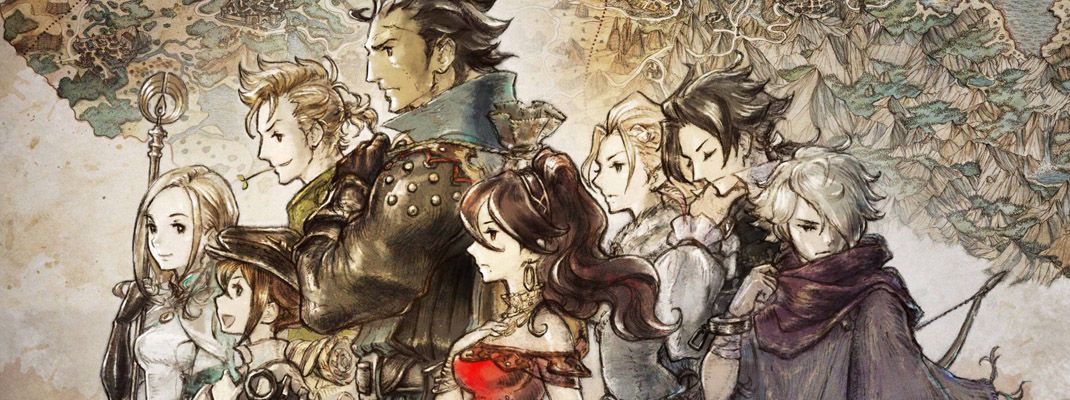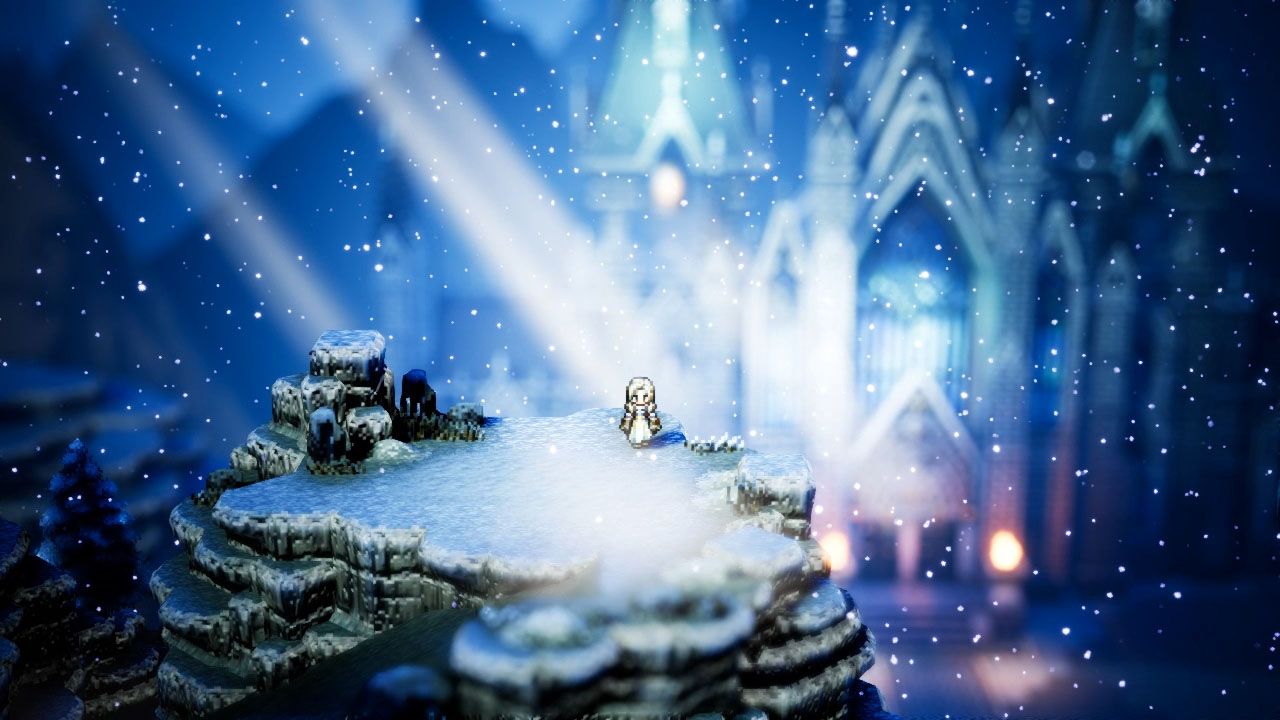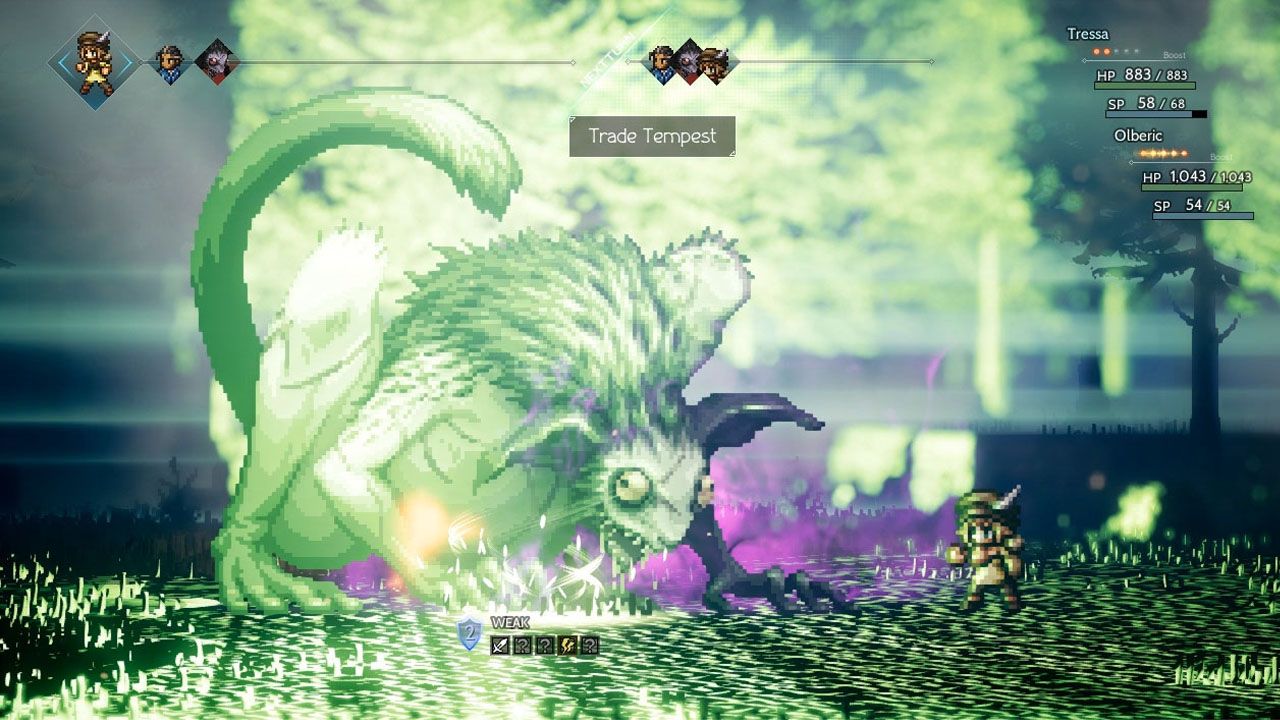Since its launch last year, the Nintendo Switch has made waves across the world, selling an exceeding number of units in such a short amount of time. This has to do with a couple things, but most importantly is the promised lineup of games. In just over a year, we’ve had some of the best experiences coming out of Nintendo in a long time and one that no doubt is going to dominate the summer is Octopath Traveler. From Square Enix and Acquire comes a love letter to the golden age of RPGs, where we didn’t have to worry about overly-complicated 3D graphics or flashy active battles, but instead sprites and methodical turn-based combat. We’ve been waiting for something like this for quite some time now and the Nintendo Switch seems like the perfect console for this adventure, but like I Am Setsuna, does this rely too heavily on nostalgia?
As far as story goes, Octopath Traveler doesn’t necessarily have an overarching narrative, which can be a bit of a problem. Not every game needs a world ending event where you slide into the shoes of some unlikely hero, but how the campaign is structured is a bit of a mess. You’re allowed to choose between one of eight protagonists, from the standard veteran knight, to the plucky merchant. This is what Octopath Traveler has going for it, as most of the cast is diverse and compelling enough to keep anyone’s attention, despite some questionable additions – such as the Huntress who speaks in crude Old English. Each has their own four-chapter story, which are fairly short, running around 4 to 5 hours each – nothing compared to what the final play time will be. The problem lies in that, these eight stories is all there is, with nothing really linking the characters together. You start with one main character (who cannot leave the group until their final quest is complete) and go around the world collecting others as you see fit. The way they join the party is that, they’re standing in town, and they’ll tell you of their conflict and ask if you’ll join them. That’s it. After this, any interaction between the characters is solely restricted to random banter in story quests, which comes all too infrequently. There’s no real reason why any of these protagonists would be traveling together, as they aren’t properly integrated in any story outside of their own. Even then, although the characters are interesting, there’s only a handful of standout stories, most notably the Dancer and the Merchant.
While the plot is a bit of a disappointment, the same can’t be said about the gameplay. Outside of the visuals, combat is one of the best parts of Octopath Traveler as it brings back turn-based combat in a big way. While large budget RPGs have abandoned the slower, methodical battles, we’re treated to combat that’s both new and old, having similar mechanics as we remember them twenty years ago, yet with their own twist. Firstly, this feels much quicker than any turn-based RPG, as you’ll be blasting through battle after battle, at least when you get the hang of things. The big new addition is the Break function, which introduces a new strategy to knock out an opponent so greater damage can be inflicted. This is similar to games such as Persona where each enemy has a weakness, be it axes, daggers or fire, and once they’re hit with it a number of times, they’ll go down. The only thing missing is the rush function. This ties into the job system, which allows new skills to be learned and perks to be equipped. It gets even more extensive when unlocking second jobs, which allows characters to utilize the eight (plus a secret four) skillsets. Finally, there are Battle Points that can be saved up during battle, which allows the player to unleash even more attacks during their turn, or stronger abilities. Each fight ends up being a strategy thanks to these inclusions, one that can be tough with end-game bosses, as players will have to plan a few steps ahead. All of these mixed with the traditional turn-based combat create a modern iteration that thankfully doesn’t overstep its bounds.
Like any good RPG, Octopath Traveler features a large open world to explore. While it isn’t the biggest you’ll see, it’s still fairly sizable with plenty of content to find, especially when it comes to small tucked away dungeons and shrines. As you progress through the story even, the areas will alter their difficulty level, bringing in newer, stronger enemies for you to obtain additional experience; it’s a smart way to keep you on your toes. It’s also varied from a visual perspective, as the southern portion of the map is desert, the east is the sea, the north is snow and the west is a mixture of mountains and forests. There’s a lot to see in the world, let alone do. Best of all, each area is easily ventured to thanks to fast travel. Fast travel is one of the smartest mechanics that could have been implemented, as all you need to do is visit a town once, and you’re able to hop there instantly. Considering there are random battles, where even escaping feels more difficult than ever before, this ensures you won’t be bogged down unnecessary battles. It feels like a true world to explore, as right from the get go you’re let loose, allowed to hop into overpowered areas where death is all but certain.
Unfortunately, while there’s plenty to praise going around the combat and exploration departments, the dungeons themselves are another matter. While each is visually impressive, the problem stems from just how short and to the point they are. There are a couple of branching paths to be found, especially later in the campaign, but they amount to nothing but one or two screens. There were dungeons where, if I had the perk to reduce enemy encounters, I could get through it in less than 30 seconds. By that, each story quest doesn’t stray away from the standard structure, as you’ll be given a little bit of story before hand, be allowed to go into a newly opened area, and then you fight a boss at the end, with things wrapping up afterwards. There can be some banter going on in-between, and of course tasks related to that character’s specific skillset, but everything is pretty guided and can be done in roughly one hour per quest. Fortunately, while the things wrap up pretty quickly, the bosses themselves are puzzles, notably in Chapters 3 and 4, and will take an exceeding amount of time to take down. Regardless, this structure could have used some work to make you think, and added larger, more thoughtful dungeons, instead of having an exceeding high number of smaller ones scattered across the map.
When it was announced, the biggest and most standout aspect of Octopath Traveler was its visuals, and we can safely say that it transitioned to the final product without fail. Square Enix and Acquire have captured the classic 2D sprite-based visuals from the 90s perfectly, giving those who grew up with games such as Final Fantasy VI and Valkyrie Profile a big kick of nostalgia. Even though the environments are 3D, the texture work has been smartly crafted to resemble the two-dimensional flair. It may not be perfect as there are areas that look more polygonal than others, but at least the characters and monsters are done in sprite form, which only enhance the experience. There’s just something so joyous about playing a game that resembles a classic 16-bit RPG, but has coatings of modern effects such as fairly realistic water. Octopath Traveler isn’t only good on the eyes, but also the ears. The music is one of the biggest highlights, being an all orchestrated soundtrack that goes well beyond what you’d hope for. It brings back memories of the golden age of JRPGs and sets the mood absolutely perfectly, from ominous scenarios to exciting boss battles. Music tends to get overlooked in most games due to flashy graphics or overly complex gameplay mechanics, but the developers were able to make it stand out here.
Closing Comments:
Octopath Traveler is a charming throwback to classic Japanese Role-Playing Games. It’s brimming with life aesthetically and the turn-based combat system is old school yet surprisingly modern. There’s a wide open world to explore with eight fascinating and unique characters to play as, and a musical score that will knock your socks off. It feels old yet new at the same time, which seems difficult to accomplish this day and age. While it deserves all of this praise and more, it’s still far from the most flawless of gems. Due to the characters having their own tales, ranging from happy-go-lucky adventuring to murderous revenge, the campaign fails to produce a meaningful narrative, instead segmented into portions where there’s little to no reason for the cast to be together. They’re just there. That’s not to mention the dungeons are some of the shortest, most uninspiring areas you’ll find in any RPG, going well beyond the issues of something like the recent Tales games. At least there’s plenty to find in the world, many offering fantastical riches and challenging boss encounters. Regardless, while there are problems with the structure and overall narrative, there’s no denying that Octopath Traveler is an alluring adventure and one of the better RPGs on the Nintendo Switch.




